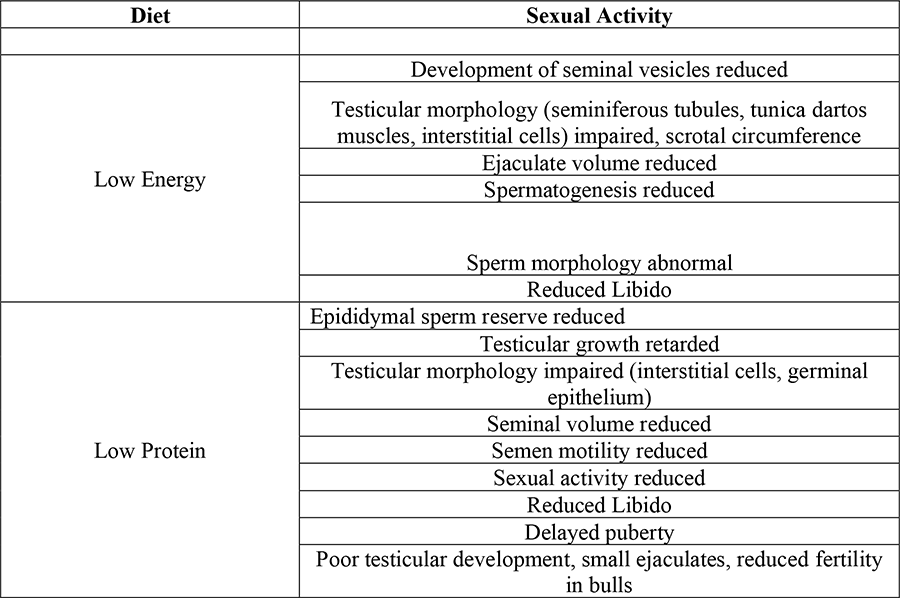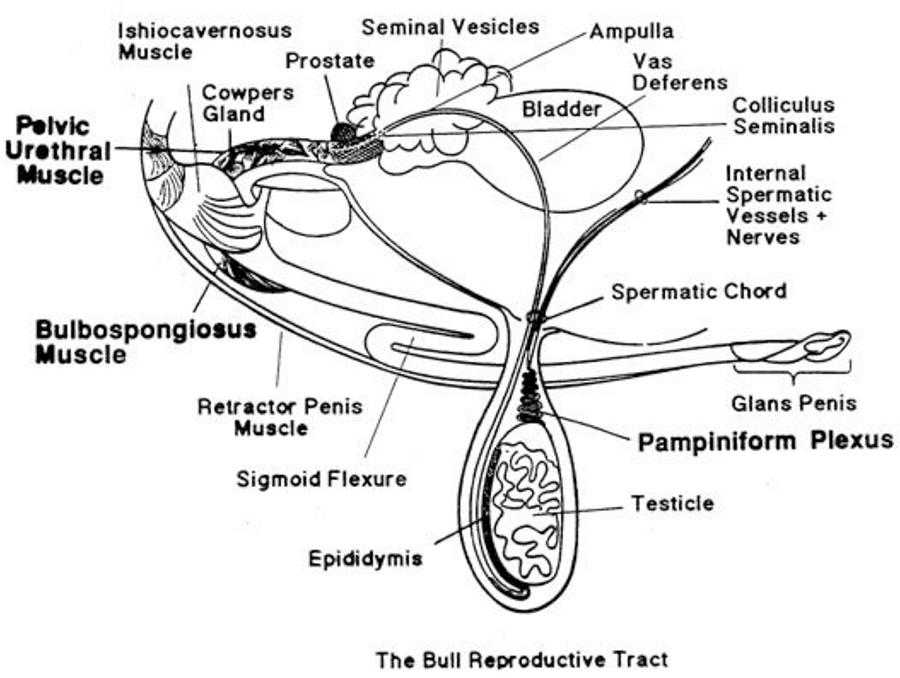The key to a successful breeding program.
Written by Darian Livingstone | Ceres Industries
(306) 653-7258 |
When discussing conception or pregnancy rates, the cow is often the center of attention. Usually, we are too quick to judge the dam, which can lead to unnecessary culling. But what if we stopped to consider the bull? After all, he is half of the equation. Bull fertility is paramount to a successful breeding program since an individual bull services numerous females. Thus, a deficiency in the bull has a greater impact on herd productivity than a single female. A bull who is subpar in reproduction can cause substantial economic losses to a cow-calf producer. Low fertility can increase calving intervals and lower calf crop numbers in addition to over-wintering unbred females.
Fertility and reproduction are not very heritable traits, meaning that a dam's ability to conceive is not passed on to her offspring. Many factors affect fertility. While the fertility of a bull depends on his genetic make-up, it heavily depends on nutrition, management, climate, stress, and even temperament. Reproductive performance—semen quality and libido—is mainly dependent on body vigour and physical soundness. To guarantee physical soundness, the appropriate weight and body condition can be controlled by nutrition. While we can't completely control the execution of a bull's reproduction, we can supply them with a stress-free environment and proper nutrition to aid performance.
During the breeding season, bulls are frequently too distracted to eat enough feed to maintain their body condition. Some bulls may lose up to 150 pounds. Proper pre-breeding nutrition is crucial to ensure your bulls have adequate energy reserves (body fat) for the upcoming breeding season. Spermatogenesis requires 60 days to complete, so farmers need to be planning a minimum of 60 days, although 90 days is preferential.
Bulls should have body condition score evaluations performed at least 60 to 90 days before the breeding season. The ideal body condition score is 3 to 3.5 since they lose about one point throughout the breeding season. Performing a BCS evaluation before the breeding season gives you time to make any necessary adjustments to your bulls' nutrition program.
This review covers several different aspects of nutrition and how they relate to bull fertility.
Energy and Protein
Table 1 shows the effects of restricting protein and energy on the functions of a bull's reproductive traits. Dietary protein and energy fed in excess or insufficient amounts can adversely affect the fertility of breeding bulls. Low dietary protein and energy can result in delayed puberty, poor testicular development, and impaired sperm production. Excessive fat deposits can affect the mobility and libido of a bull, but also reduce sperm counts due to the higher scrotum temperature. Unfortunately, there isn't enough research in this area to clearly define the parameters.
A mature breeding bull's diet should contain approximately 1 to 1.2 kg of protein and 6 kg of energy in the form of total digestible nutrients (TDN) per day. Young bulls who are working in the pasture while growing to their mature size will require substantially more; 1.5 to 2 kg of protein per day and 7.2 to 9 kg of TDN.

Table 1. Effects of different levels of energy and protein on the reproductive traits and sexual activity of farm animals. Adapted from Singh, A., et al. 2018.

Figure 1. A diagram showing the reproductive tract of the bull. Used to support Table 1 description.
Minerals
Minerals are fundamental for all body functions to perform correctly. So, it should be no surprise that mineral deficiencies can negatively impact reproductive performance. Magnesium, which is present in semen at high concentrations, can be supplemented to improve sperm production and motility. Zinc is also present in seminal fluids at high levels. Zinc has an impact on the production and secretion of testosterone. It is also vital for spermatogenesis and the development of sex organs.
The National Research Council recommends feeding bulls a minimum of 30 ppm of zinc and 20 ppm of manganese per day.
Vitamins
Vitamins are known to be antioxidants and are crucial to the immune system (see Vitamin E in Equine Diets). Their antioxidant properties are important for the development of healthy sperm in large quantities. Oxidative stress caused by free radicals—often caused by undernutrition—usually impedes spermatogenesis.
Following the breeding season, a bull's focus is to regain any lost body weight. The age of the bull dictates the appropriate nutrition management protocol, depending on how much weight is lost. Young bulls, such as yearlings and two-year-olds, need extra supplementation as they recover because they are still growing. Mature bulls exiting the breeding season in relatively good condition can survive on a roughage-based diet, provided all the micronutrient requirements are met.
Since reproductive traits are not highly heritable, greater selection intensity is required to achieve genetic improvements. Genetic improvements are slow and take generations to achieve the desired results. Proper nutrition is needed to ensure that the bull's reproductive development and performance are obtained in a timely fashion. Supplementing your bulls before the breeding season with supplements such as Saltec High Energy 30 can ensure your animals are prepared for the busy seasons coming up. Saltec Ultra TM 120 is a fantastic salt block to use for young and working bulls because of the high levels of zinc it has.
Reference
Boyles, S. N.D. Bull Nutrition and Management. Ohio State University. https://agnr.osu.edu/ sites/agnr/files/imce/pdfs/Beef/BullNutritionAndManagement.pdf
Hamilton, T., 2006. Beef Bull Fertility. OMAFRA. [blog] http://www.omafra.gov.on.ca/ english/livestock/beef/facts/06-015.html
Kellems, R., Church D.C.. 2010. Livestock Feeds and feeding 6th edition. Pearson Ag. Upper Saddle River, New Jersey.
Singh, A., Rajak, S., Kumar, P., Kerketta, S., Yogi, R. 2018. Nutrition and bull fertility: a review. J. Entomology and Zoology Studies. 6(6): 653-643.
Walker, J., Perry, G., Olson, K. 2013. Bull Nutrition – Achieving Yearling Breeding. The Cattle Site. [blog] https://www.thecattlesite.com/articles/3508/bull-nutrition-achieving-yearling- breeding/
Walker, J., Perry G., Daly, R., Olson, K. 2009. Bull Management and Nutrition. University of Nebraska - Animal Science Department. https://digitalcommons.unl.edu/c gi/viewcontent.cgi?article=1276&context=rangebeefcowsymp


